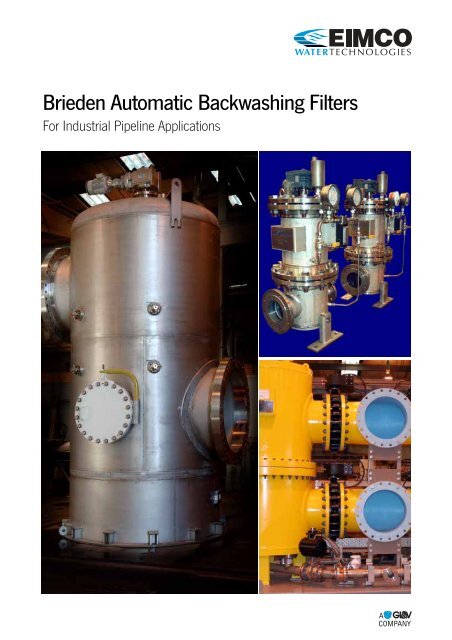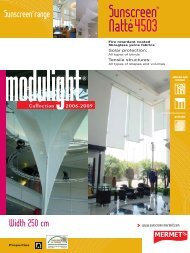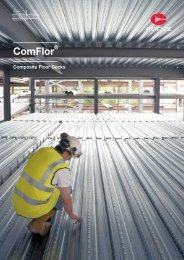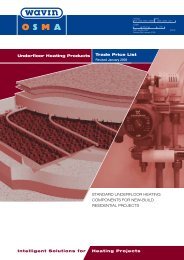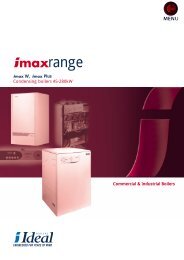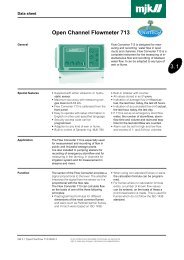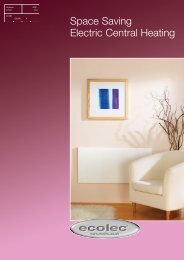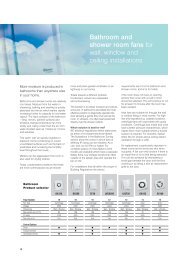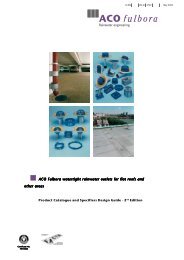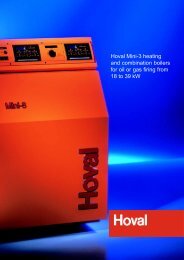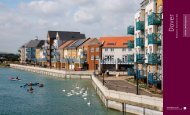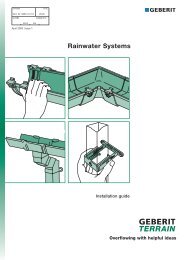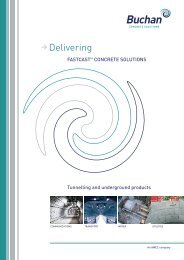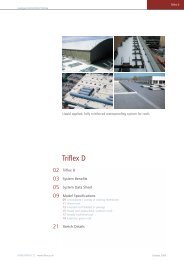Brieden automatic backwashing filters - CMS
Brieden automatic backwashing filters - CMS
Brieden automatic backwashing filters - CMS
You also want an ePaper? Increase the reach of your titles
YUMPU automatically turns print PDFs into web optimized ePapers that Google loves.
<strong>Brieden</strong> Automatic Backwashing Filters<br />
For Industrial Pipeline Applications<br />
A<br />
COMPANY
2<br />
<strong>Brieden</strong> Automatic Backwashing Filters<br />
Developed and manufactured<br />
by Eimco Water Technologies<br />
(EWT), <strong>Brieden</strong> <strong>filters</strong> provide a<br />
comprehensive range of industrial<br />
<strong>automatic</strong> <strong>filters</strong> for diverse<br />
applications, guaranteeing a pure<br />
and reliable source of filtered<br />
fluids. <strong>Brieden</strong> <strong>filters</strong> offer a fully<br />
<strong>automatic</strong>, completely self-cleaning<br />
cycle of operation, that continuously<br />
separates impurities<br />
from water and other liquid. Simple<br />
to maintain and operate, the <strong>filters</strong><br />
are built to last and deliver a<br />
consistent performance even in<br />
aggressive operating conditions.<br />
<strong>Brieden</strong> <strong>filters</strong> are manufactured<br />
to the highest quality and are<br />
rigorously tested. This is particularly<br />
important when <strong>filters</strong> are<br />
installed in demanding locations<br />
such as offshore platforms and<br />
remote refineries. Accordingly, all<br />
<strong>Brieden</strong> <strong>filters</strong> comply with both<br />
BSI9001 and ASME regulations.<br />
Filter body designs are generally<br />
based on PD5500 guidelines for<br />
pressure vessels. However, they<br />
can be adapted to incorporate<br />
specific requirements of other<br />
design codes. Bodies can be<br />
manufactured from carbon steel<br />
with rubber or glass flake lining,<br />
stainless steel, duplex or super<br />
duplex stainless steel. Other materials,<br />
such as titanium, can be<br />
offered.<br />
Filter elements are available with<br />
either EWT’s patented design of<br />
‘breathing element’ manufactured<br />
from polypropylene wafers or<br />
fixed wedge wire ‘V’-Gap elements.<br />
Because different process<br />
applications require different<br />
filtration techniques, EWT has<br />
produced separate guides for<br />
breathing and V-Gap elements<br />
<strong>filters</strong>. Breathing elements are<br />
generally more suited to processes<br />
demanding a finer degree<br />
of filtration and where fibrous or<br />
sticky media would be difficult<br />
to backflush from wedge wire<br />
elements.<br />
All <strong>filters</strong> feature access to the<br />
elements through a strategically<br />
positioned port on the top of the<br />
filter body which allows replacement<br />
of single elements quickly<br />
and easily, eliminating the need<br />
for disassembly of the filter body<br />
and the consequent loss of valuable<br />
operating time.<br />
Applications include:<br />
• Automotive industry<br />
• Nuclear industry<br />
• Offshore production platforms<br />
• Paper processing<br />
• Pharmaceutical industry<br />
• Plastics industry<br />
• Thermal power stations<br />
•Waste water treatment plants
Backflushing<br />
The fluid to be filtered flows<br />
through the inlet connection into<br />
the lower half of the filter body,<br />
upwards through the turntable<br />
into the inside of the filter elements.<br />
Flowing from the inside to<br />
the outside of the filter elements,<br />
the solids are retained on the<br />
inside of the filter candles. The<br />
clean fluid then leaves the filter<br />
body through the upper outlet<br />
connection.<br />
The requirement to backflush<br />
is initiated by a timer or rising<br />
differential. When the signal to<br />
backflush is given, one complete<br />
backflush cycle would be performed<br />
fully <strong>automatic</strong>ally. Backflushing<br />
is achieved without interruption<br />
to the flow through the<br />
filter. The drive rotates the turntable<br />
and the backflush valve is<br />
opened. Each element in turn<br />
moves across the backflush outlet<br />
pipe.<br />
The difference in pressure between<br />
the inside of the filter body<br />
and atmospheric pressure produces<br />
a reverse flow through the<br />
filter elements thereby removing<br />
the retained debris. After one<br />
revolution of the turntable the<br />
backwash cycle is completed.<br />
The backflush valve closes and<br />
the drive motor stops.<br />
<strong>Brieden</strong> Filters can vary the number<br />
of candles in each filter to<br />
present the maximum filtering<br />
area to the flow. This enables<br />
<strong>Brieden</strong> <strong>filters</strong> to be applied with<br />
the minimum headloss possible<br />
across the strainer.<br />
<strong>Brieden</strong> filter key<br />
1 Filter body<br />
2 Filter elements (candles)<br />
3 Pressure gauge<br />
4 Differential pressure switch<br />
5 Drive<br />
6 Revolving turntable<br />
7 Backflush pipe<br />
8 Backflush valve<br />
9Turntable seal<br />
10 Access cover<br />
11 Automatic vent<br />
Principle of Operation<br />
An EWT <strong>Brieden</strong> strainer during backflushing operation<br />
3
4<br />
Breathing Filter Guide<br />
EWT recommends ‘breathing’ elements for applications<br />
where difficult filtration problems are expected.<br />
Extensive research and development into nonmetallic<br />
elements by EWT has resulted in a patented<br />
design for polypropylene elements that<br />
have revolutionised filtration techniques. Field<br />
trials have been successfully performed to show<br />
the suitability of the breathing element for duties<br />
involving screened sewage. This capability has<br />
enabled the <strong>Brieden</strong> filter to be used for the supply<br />
of washwater using only screened sewage.<br />
As suggested by their name, breathing elements<br />
have the ability to widen during the backflushing<br />
process and avoid becoming blocked by stubborn<br />
waste matter. Solids retained in the filtration process<br />
are deposited inside the elements (Diagram 1).<br />
When backflushing commences, the flow direction<br />
is reversed, with media travelling through the<br />
elements from outside to inside. Backflushing<br />
widens the filter gaps for a very short time – the<br />
breathing effect – allowing even the most persistent<br />
waste particles to be flushed out (Diagram 2).<br />
Diagram 1. The medium which is to be filtered flows through the<br />
‘breathing filter element’ from the inside to the outside. All impurities<br />
with size greater than that of the selected grade of filtration are<br />
deposited inside the filter elements. The size of the gap is precisely<br />
fixed by appropriate spacers.<br />
Diagram 2. The filtered medium flows through the ‘breathing filer<br />
element’ from the outside to the inside. The effect of this backflushing<br />
is to widen the filter gap, suddenly and for a brief period, (this is<br />
the ‘breathing effect’). Even the most persistent of impurities can be<br />
backflushed and will not block the filter cartridge.<br />
The filter elements in a <strong>Brieden</strong> backflushing fil ter
Selecting the correct filter<br />
The choice of filter is dependent<br />
on site operating conditions and<br />
the filtration requirements of the<br />
system. The following factors<br />
should be taken into consideration:<br />
•Type of fluid to be filtered<br />
• Flow rate<br />
• Level of filtration<br />
•Volume of solids present<br />
(if known)<br />
• System pressure<br />
Breathing elements are available<br />
with apertures ranging from 50µm<br />
to 1,000µm and are renowned for<br />
their operational longevity – some<br />
elements have been in use in<br />
<strong>filters</strong> for over 20 years.<br />
Table 1 provides a guide to filter<br />
specification, based upon filtration<br />
of media in m 3<br />
/hour at ∆p<br />
approximately .15 bar.<br />
Breathing Filter Guide<br />
Table 1. Breathing Element maximum flow capacities m 3<br />
/hour.<br />
The table provides a guide to filter specification, based upon filtration of media in m 3<br />
/hour<br />
at ∆p approximately .15 bar. For flows greater than 9000m3/hour refer to EWT’s range of<br />
Debris <strong>filters</strong> – BGWSA Debris Filter catalogue.<br />
Breathing filter element Wedge wire filter element<br />
5
6<br />
V-Gap Filter Guide<br />
EWT has fined-tuned the traditional<br />
wedge wire filter element<br />
to produce stainless steel, duplex<br />
or super duplex ‘V’-Gap elements.<br />
V-Gap elements are capable of<br />
effectively filtering less clinging<br />
impurities, or where coarser filtration<br />
is acceptable.<br />
Their advanced aperture shape<br />
helps to deter media from causing<br />
blockages that would result<br />
from using more orthodox wedge<br />
wire elements, and they are particularly<br />
recommended for use<br />
when very high differential pressure<br />
is present.<br />
Internal dimensions of V-Gap elements<br />
are correlated to the required<br />
filtration aperture and open<br />
in the direction of the flow. This<br />
design (Diagram 1) means that<br />
solids and media requiring separation<br />
are received in front of the<br />
apertures. Backflushing is performed<br />
by reversing the flow and<br />
using the filtered fluid to clean<br />
elements (Diagram 2).<br />
Selecting the correct filter<br />
The choice of filter is dependent<br />
on site operating conditions and<br />
the filtration requirements of the<br />
system. The following factors<br />
should be taken into consideration:<br />
•Type of fluid to be filtered<br />
• Flow rate<br />
• Level of filtration<br />
•Volume of solids present<br />
(if known)<br />
• System pressure<br />
Wedge wire elements are available<br />
with apertures ranging from<br />
50µm to 3,000µm and are renowned<br />
for their operational longevity<br />
– some elements have been<br />
in use in <strong>filters</strong> for over 20 years.<br />
Table 1 provides a guide to filter<br />
specification, based upon filtra-<br />
Diagram 1. Filtration<br />
V-Gap filter elements are manufactured from<br />
wedge wire and have ‘V’ shaped filtration<br />
apertures. Internal dimensions correspond<br />
to the required filtration aperture and open<br />
out in the direction of the flow. For this<br />
reason solids to be separated are received<br />
in front of the filtration apertures. The V-Gap<br />
shape minimises solids becoming lodged<br />
within the filter and prevents blockages.<br />
tion of media measured in m 3<br />
/hour<br />
at a ∆p of approximately .15 bar.<br />
For large capacity <strong>filters</strong>, other<br />
applications, filtering systems<br />
with a high solids loading, or for<br />
further information on any of our<br />
strainers please consult EWT.<br />
Diagram 2. Backflushing<br />
Backflushing is carried out by reversing the<br />
flow using the filtered fluid to clean the<br />
filter elements. V-Gap filter elements have<br />
excellent filtration properties and are<br />
suitable for high differential pressures. For<br />
special requirements, fine filtration and<br />
difficult applications, such as sewage which<br />
has fibrous or waxy solids we would<br />
recommend our ‘breathing filter elements’.<br />
Table 1. Wedge wire maximum flow capacities<br />
For flows greater than 9000m 3<br />
/hour refer to EWT’s range of Debris <strong>filters</strong> – BGWSA Debris<br />
Filter catalogue. Wedge wire elements are available with apertures ranging from 50µm<br />
to 3,000µm.
<strong>Brieden</strong> Automatic Backwashing Filters<br />
EWT provides a comprehensive<br />
range of industrial <strong>automatic</strong><br />
<strong>filters</strong> for diverse applications.<br />
Filters are supplied to the nuclear<br />
industry which require complex<br />
specifications.<br />
7
Brunel Way<br />
Colchester<br />
Essex, C04 9QX<br />
© Copyright 2006 GL&V. . BG030106 For more information visit us at www.glv.com<br />
Tel: +44 (0) 1206 756600<br />
Fax: +44 (0) 1206 756500


